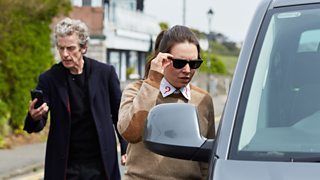Smile: The Fact File
The read-through for Smile took place on 14 June, 2016 and the episode was filmed the following month. Production included shooting at the City of Arts and Science Museum in Valencia, Spain.

Ralf Little (Steadfast in Smile) is no stranger to the Time Lord’s world… He voiced Guy Fawkes in 2011’s The Gunpowder Plot, the fifth and final episode of Doctor Who: The Adventure Games…
…and Mina Anwar, who plays Goodthing, is also a well-known face in the Doctor Who universe. She starred as Gita Chandra in four series of The Sarah Jane Adventures.
Other familiar names on the credits include Kiran Shah who plays an Emojibot in Smile, having previously featured in 2014’s Listen. The episode is written by Frank Cottrell-Boyce (In the Forest of the Night) and Lawrence Gough, fresh from helming The Pilot, is back in the director’s chair for the follow-up story.
Emojis as we know them today date back to the late 1990s and the word itself comes from the Japanese e (meaning ‘picture’) and moji (meaning ‘character’ or ‘letter’).
The Doctor is seen tinkering with a ‘Fleishman cold fusion engine’. This inevitably brings to mind the British chemist Martin Fleischmann (1927 -2012), a controversial figure who, along with his colleague, Stanley Pons, declared that they had produced fusion at room temperature in 1989. The process was soon after dubbed ‘cold fusion’. It’s worth noting, however, that the name as it appears on the apparatus the Doctor reconfigures is spelt ‘Fleishman’.

What’s the Doctor got to hide? In Smile he tells Bill, ‘Stay away from my browser history!’ echoing his plea to Osgood in The Zygon Inversion where he requested, ‘Don’t look at my browser history!’
Bill is still learning about the Doctor and in this episode she discovers he has two hearts! This aspect of his anatomy was first revealed in the 1970 adventure, Spearhead from Space, when a medic ran tests on the unconscious Time Lord and came across the anomaly, initially believing it to be a hoax!
We’ve seen the Doctor visiting many Earth colonies including settlements on Pluto (in The Sun Makers), Frontios (in the Fifth Doctor adventure of that name) and Uxarieus in the appropriately titled, Colony in Space.

Similarly, the idea of humanity engaged on a hazardous journey through the cosmos to find a new home has been the basis for many Doctor Who adventures, ranging from The Ark in Space to Utopia. The concept was first explored in the 1966 story, The Ark, where the TARDIS travelled to the distant future, landing on a vast spaceship that’s on a 700-year mission, transporting Earth’s surviving plant and animal life (including mankind) to the planet Refusis II.
Coincidentally, we see an elephant at the very end of Smile and over fifty years earlier, The Ark was the first Doctor Who story to feature an elephant. In the 1960s adventure it was a baby Indian elephant, named Monica!
